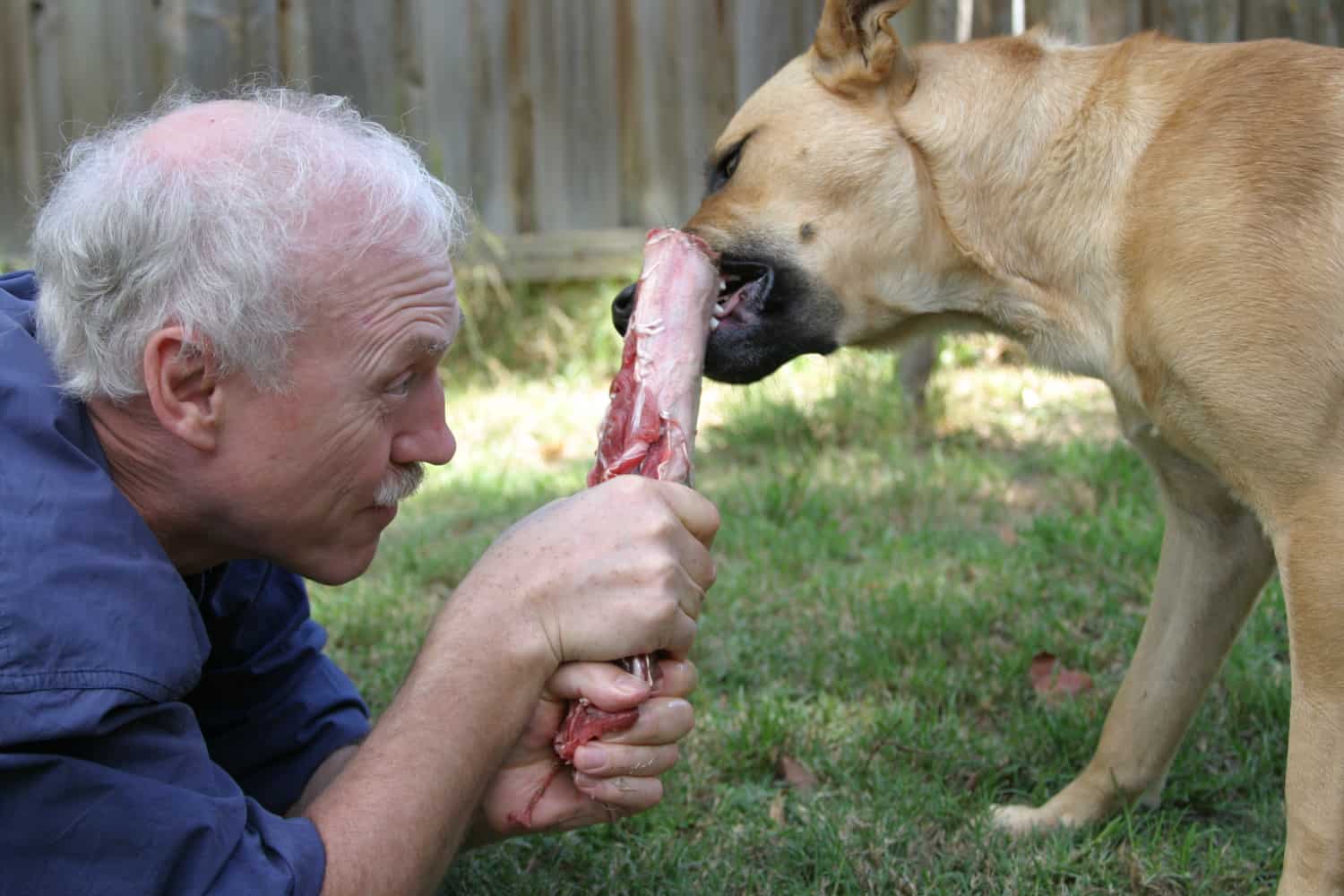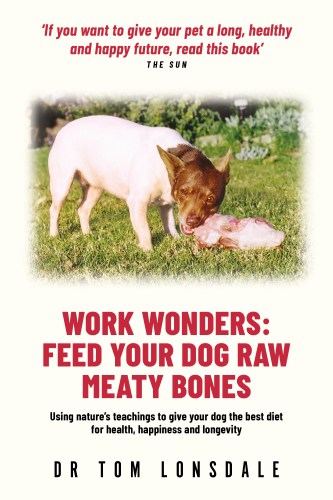If you have a dog or cat – as approximately a third of all UK adults do – and are concerned about their wellbeing, this book is an absolute must-read.
For Multi-Billion-Dollar Pet Food Fraud: Hiding in Plain Sight by respected vet Dr Tom Lonsdale provides a devastating exposé of the global pet food industry and warns that it may be responsible for nothing less than a global pet sickness pandemic.
Informative and alarming in equal measure, the book pillories the multinational manufacturers of ‘junk pet food’ from canned pet food to kibble – estimated to be worth $128bn worldwide by 2027 – claiming that this staple industrialised diet is neither nutritious nor healthy for pets.
Indeed, according to Dr Lonsdale’s three decades of research, a diet of highly processed pet food, essentially consisting of grain and vegetables, is totally unsuited to the needs of carnivores not just because of the poor-quality ingredients but because of the food’s texture.
In the wild, he explains, carnivores hunt their prey and eat the raw meaty bones, which has the added virtue of keeping their teeth and gums clean through the abrasive ripping motion employed. Given that dogs are, basically, ‘modified wolves’ and cats ‘modified desert predators’, the same mechanism applies, but is not being served by the soft food in their bowls.
So, then, this leads to dental and gum disease setting in within the first few years of a pet’s life, and the consequences can be terrible, resulting in a wide range of chronic and acute health conditions including diabetes, cancer, and heart disease, as well as the associated foul breath, intestinal upsets and negative behavioural changes.
More deplorably, according to Dr Lonsdale, the junk pet food companies are well-aware that their products do harm but continue regardless in the name of profit.

Many veterinary practices and veterinary schools collude with the pet food companies, he claims, with significant funding going to veterinary schools to ensure the scientific and medical consensus remains firmly on the side of junk pet food, which is then promoted to pet owners through relentless advertising.
You can see why Dr Lonsdale, who ran a successful veterinary practice in Australia for 40 years until his retirement in 2022, has been dubbed the ‘whistleblower vet’.
While a controversial figure within the veterinary profession, he will go down in history as the pioneer of the raw meaty bone diet and has written extensively on why and how to switch pet dogs and cats over to that diet, providing the requisite nutritional and teeth-cleaning properties to keep them active and happy.
Based on tried-and-tested observation, he insists dogs and cats big and small should be eating high-quality raw meaty bones – similar to what their wild ancestors would have eaten – which he says will dramatically improve health.
Crucially, he explains, it prevents gums from becoming sore and inflamed, and has been shown to stimulate the immune system and gut enzymes, as well as bring improved vitality and less aggression (currently there are 8,000 dog bites each year in the UK that require hospital admission).
As he writes in Multi-Billion-Dollar Pet Food Fraud, “Basic biological and nutritional definitions tell us that carnivores with anatomy, physiology and behaviour fashioned by nature should not be forced to dwell in solitary confinement forced to consume industrial grain-based junk.”
If Dr Lonsdale is correct, then a pet health revolution can be brought about just by buying raw meaty bones for your dogs and cats.
His brilliant and stimulating book also explores how this epidemic of pet illnesses is costing pet owners billions of pounds for needless vet visits.
The statistics are shocking. According to various studies, some 80 percent of dogs and 85 percent of cats over the age of three have some form of periodontal (gum) disease.
Indeed, in Dr Lonsdale’s own practice, he was seeing 85 percent of pets with this ailment.
But the book goes even deeper than this, offering a complete overview of the issues and shadowy practices of the junk pet food industry, while weaving in Dr Lonsdale’s own unique crusade against the corporate giants and their minions.
His journey is most revealing about the wider veterinary sector. Having worked in the UK, Australia, and Africa, he explains how – as a young vet – he had no interest or training in nutrition.
It was only at the dawn of the 1990s that he began to link the poor health of the animals he was treating to their diets.
But, as he soon learned, this is not an easy situation to rectify.
Pet owners are, he says, basically brainwashed into believing the pet food industry’s chapter and verse, and with the industry having become one of the ‘great success stories of the business world’ since its origins in the late 19th century, this is no surprise.
Dr Lonsdale paints a picture of the leading manufacturers dominating the market and narrative with a business model built upon propaganda and advertising, or as the author would describe it, the dissemination of misinformation to provide the illusion that their products are the perfect solution to every pet’s nutritional needs.
He goes on to state there is a web of parties complicit in the “fraud”, from vets and scientists to journalists and politicians, with the multinationals leading the charge with efforts to “control the science” through governmental lobbying and university partnerships.

Dr Lonsdale discusses openly the difficulties he has faced in getting his views heard – and the hurdles placed in front of pet owners who want to take up cases against pet food companies.
Multi-Billion-Dollar Pet Food Fraud is packed with pet owner testimonials supporting the author’s position and as one explains, “It is quite clear that my dog’s previous ill health was entirely due to his diet of processed dog food.
‘This is a particularly alarming insight when we take into account the fact that the expensive canned food that I was feeding him was specifically developed for dogs with digestive difficulties.”
Dr Lonsdale is something of a lone voice. However, given the power of the multinationals, it’s easy to understand why this may be the case.
A review can only hope to touch the surface of what seems a very deep and messy affair, and readers must make their own judgement call on what is best for their pets.
There’s no denying, however, that Dr Lonsdale argues his case well, bringing a lot of supporting evidence, logic, and science to the table, making it a very persuasive argument against processed pet food and for raw meaty bones.
And if you agree with the contents of Multi-Billion-Dollar Pet Food Fraud then you can learn more about the topics of pet food fraud and a raw meaty bones diet in the author’s previous two books, which have just been reissued alongside his new book: Raw Meaty Bones: Promote Health (2001) and Work Wonders: Feed Your Dog Raw Meaty Bones (2005).
With so much attention on what we eat, perhaps it is time to reflect further on the food that we provide our pets. If you are a pet owner then for dogs’ sake, read Dr Tom Lonsdale’s books.
Multi-Billion-Dollar Pet Food Fraud: Hiding in Plain Sight by Dr Tom Lonsdale is available on Amazon in paperback, eBook, and audiobook formats, priced £13.59, £7.99 and £8.48 respectively. For more information, visit www.thepetfoodcon.com or follow Dr Lonsdale on YouTube.
Q&A Interview with Dr Tom Lonsdale
We speak to whistleblower vet and raw meaty bones diet pioneer Dr Tom Lonsdale, author of Multi-Billion-Dollar Pet Food Fraud, to find out more about nature’s ‘miracle food’ and why we should all consider feeding our pet dogs and cats raw meaty bones rather than pre-packaged pet food.

Q. Can you explain how, in the natural world, raw meaty bones act as both food and medicine for carnivores, and why the same rules apply to our pet dogs and cats?
A. Over millennia, we’ve developed a vocabulary that distinguishes between what we call ‘food’ and what we call ‘medicine’. By giving things a name, they gain recognition, validity, and enter into everyday parlance. Take a look at wolves and wild cats and they consume what we would call ‘food’, but they don’t have a chemist’s shop. By looking more closely at the ‘food’, we see that it provides what we recognise as nutritional benefits. Additionally, carnivore food provides benefits similar to therapeutic agents we may find in a chemist’s shop. The important medicinal benefits, in large part, derive from the physical texture of the food – for instance teeth cleaning and stimulating the flow of brain chemicals and digestive juices.
The same rules apply for our pet dogs and cats simply because nature sets the rules for carnivores and by definition dogs (modified wolves) and cats (modified desert predators) are carnivores.
Q. You have been campaigning for raw meaty bones for more than three decades. What is the greatest obstacle you have faced in getting your message accepted by pet owners?
A. The greatest ultimate obstacle is the cultural conditioning affecting every aspect of pet keeping in the Western world. False and misleading messages repeated for decades locks in place the false and misleading ideas we’ve all grown up with.
However, there are two immediate obstacles standing in front of the biggest obstacle.
First are the opportunist BARFers, Prey-Modellers and sundry self-opinionated RAW (Righteous And Wrong) folks who misappropriated/plagiarised/distorted the raw meaty bones message. They depend on the continued existence of the junk pet food/vet alliance for their sanctimonious rhetoric. This gives them comfortable niches and assumed authority with which to push their half-baked, watered-down ideas and sell their junk raw products and supplements. They are relentless self-promoters who steal the oxygen out of any raw meaty bones discussions. And they specifically downplay and suppress the raw meaty bones essentials.
Immediately behind the opportunist BARFers et al are the conventional vets in a protective cordon in close alliance with the junk pet food monsters. Conventional vets, in this scenario, have a dual role. They pour scorn on the BARFers et al and thus reinforce the conventional vet self-proclaimed superiority and objectivity. Simultaneously they endorse and promote the junk food makers and the makers of pet toothbrushes and dental chews.
Q. You have three books that form a raw meaty bones trilogy of sorts. Where should readers begin, and why?
A. Each of the books contains the basic practical information enabling pet owners to make a start with feeding their pets.
Work Wonders: Feed Your Dog Raw Meaty Bones is the 120-page easy reader. Every pet owner, not only of dogs but cats, ferrets and other carnivores, should read the book.
Raw Meaty Bones: Promote Health was my first book in 2001, intended to be the definitive statement on the nutrition, science, economics, and politics of pet feeding, corporate and veterinary incompetence and, in many instances, corruption. Thirteen chapters support Chapter 14, which proposes a new paradigm of health and disease of benefit to human and veterinary medicine, and biological science more generally. Every vet, pet professional and medical researcher should read the book.
Multi-Billion-Dollar Pet Food Fraud: Hiding in Plain Sight brings things up to date. There’s plenty of testimonials to help pet owners better understand what’s needed. There are exposés on conventional vets, politicians, journalists, alternative vets, and welfare groups, all of whom have either failed in their function or actively sought to suppress vital raw meaty bones-based information essential for the welfare of pets and the wider community. I hope that where Raw Meaty Bones was suppressed and ignored, this new book assumes the mantle as the Silent Spring (the book that kick-started the environmental revolution) of pet keeping, veterinary, and medical research.


Q. Who do you hope to reach and persuade through the publication of your new book, Multi-Billion-Dollar Pet Food Fraud?
A. Everyone who lives in a society where pet dogs and cats are kept as pets should be aware of the information in this book. It’s chock full of biological, dental, and medical information that should form the basis of general knowledge for all citizens. And better that the citizens receive this information whilst still at school.
The book is a series of parables within one larger parable about systemic failures of professions and systems we depend on to protect us—veterinarians, veterinary schools, media, politicians, regulators and the law. School students need to develop critical thinking. This book provides real-world, real-life examples of what Hans Christian Andersen described in the Emperor’s New Clothes.
Q. In Your new book you accuse the pet food and pet health care industries of gross deficiencies and corruptions. If this is so, why has there been no regulatory or government intervention to-date?
A. As with the boiling frog, the deficiencies and corruption developed slowly and imperceptibly. Matters of animal welfare, medicine, and nutrition have been delegated to the veterinary profession. The vet profession moral compass fell overboard and now the profession is adrift on a sea of lies. Vets as arbiters and regulators of all things pet occupy all the pivotal positions in government. The media, the advertising industry, and legal profession defer to the vets.
Q. You come down hard on many veterinary practices and veterinary schools for, as you see it, colluding with ‘junk pet food’ manufacturers. Why would they do this when they have an enshrined duty of care to animals?
A. Because they know no other way. The cultural conditioning runs so wide and so deep that they can easily turn a blind eye. Institutions and the individuals within are adept at compartmentalising and thus refusing to contemplate the broader issues. Those that have ascended the greasy pole to the top like things the way they are. Those at the bottom only see the greasy pole. Individuals within the system, even if they’re motivated to say or do something, are soon pressured into self-censorship.
Q. If raw meaty bones are better for pets, why aren’t pet food manufacturers jumping on the opportunity to release new products?
A. Big companies are letting start-up companies establish new markets before buying the successful ones. However, these new ‘products’ are junk raw products and recipes that lend themselves to packaging, branding, and trade marking. Consumers are held hostage.
Raw meaty bones and lumps of offal are a generic product that can’t be trademarked and only have reasonable profit margins, suitable for cottage industries. The business model of junk food manufacturers, dependent on economies of scale and big advertising budgets, is not well suited to sale of generic products.
Q. If a pet is eating processed pet food but with no visible signs of illness, is it OK to continue with this diet?
A. No. Pets wear a fur coat and seek to disguise any signs of ill-health. Most vets when presented with junk food-fed pets are unaware of the multiple factors affecting the animals. However, when those same animals stop eating junk ‘food’ and switch to a raw meaty bones diet, owners are almost always shocked and surprised at the noticeable changes. For instance, general contentment, peaceful sleeping, lively activity levels, silky glossy coat, and virtually odourless stools.
Q. You have described pet dogs as “modified wolves”. In the long-term, how would you like perceptions of our pets to change, and why is this important?
A. Since the 1860s when Charles Cruft hit on the idea to promote pedigree dogs shows as a means to encouraging the consumption of Jack Spratt’s dog biscuits, there’s been a relentless drive to increase the number of pets and to see them not as sentient creatures with strict biological needs but as furry toys. This completely overlooks the biological needs of pet dogs and cats.
It’s time to get back to basics. Everyone who wants a pet carnivore should be provided with an education. Information on the anatomy, physiology, behaviour, housing, and training needs of pack animals (modified wolves) and solitary carnivores (cats) should be a function of general knowledge.
Q. What would you advise any pet owner who believes their pets’ health has been affected by ‘junk pet food’ to do?
A. They should visit www.ThePetFoodCon.com and bone up on what’s at issue. They should be prepared to ‘unlearn’ everything they had previously believed to be true and attempt to gain as much sure knowledge as is available – including watching the videos on my YouTube channel, Tom Lonsdale – The Whistleblower Vet.
Since, in the current day, most vets are not a reliable source of information, owners need to see themselves as the best source of information and protection for their pets. Thereafter, it depends on how militant the pet owner feels about, for instance, instructing lawyers and lobbying politicians in an attempt to overcome the massive fraud.

